Fujifilm FinePix F100fd Review
Review Date: September 18th 2008
Author: Mark Goldstein
Leave a comment about this Review
|
Introduction
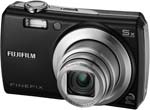
The Fujifilm Finepix F100fd is the successor to the F50fd camera, replacing it as the top-of-the-range model in the popular F-Series. The F100fd offers a 12 megapixel, 8th Generation Super CCD sensor and 5x wide angle optical zoom lens (28-140mm equivalent) complete with CCD-shift dual image stabilisation system. There's also a 2.7 inch LCD screen, new expanded dynamic range capture functionality borrowed from the FinePix S5 Pro DSLR, Face Detection 3.0 technology which can identify faces at much more extreme camera angles than before, and ISO settings of up to ISO 12800. Unfortunately the F100fd has also lost the true manual controls in the form of aperture-priority and shutter-priority modes of its predecessor, making it less appealing to the keen shutterbug. Mark Goldstein found out if the £200 / $300 Fujifilm Finepix F100fd still offers enough to pique his interest.
Compare Prices
Support PhotographyBLOG: Buy the Fujifilm FinePix F100fd from one of our affiliate retailers:Ease of Use
The Fujifilm Finepix F100fd is a fairly compact digital camera that fits into both the palm of your hand and a trouser pocket. With dimensions of 97.7(W)× 58.9(H)× 23.4(D) mm and weighing only 153g, this is a camera that you can slip into a pocket or small bag and not notice until you need to use it. The F100fd is only a little larger than the older F50fd model, despite the very welcome move to a 5x zoom lens (the F50fs had a 3x zoom). Fujifilm have also made a couple of subtle design changes to the F100fd when compared with the older F50fd. It's a little less sculpted, with very subtle curves on the top, left and right of the camera body. The Fujifilm Finepix F100fd is quite pleasing on the eye, with either a stylish champagne or more somber black colour scheme and a rounded, compact appearance. It retains the excellent overall finish of the Fujifilm Finepix F-series cameras, and generally looks and feels more expensive than it actually is.
The Fujifilm Finepix F100fd is a little more tricky to hold than it really should be, with just a small raised area on the back of the camera where your right thumb is naturally positioned, and no handgrip at all on the front. Your right forefinger is then free to operate the shutter button and the zoom lever, which surrounds the shutter button. Thankfully, despite the smooth all-plastic body, the camera is not too slippy when gripping it. The various buttons are well-made and easy to operate, and the camera feels well-balanced in your hands. There are no real innovative features here, but everything that the Fujifilm Finepix F100fd does, it does well. Overall the Fujifilm Finepix F100fd is well constructed and designed with no obvious signs of corners being cut.
The Fujifilm Finepix F100fd has relatively few external controls, just 9 in total, reflecting the fact that it only offers a limited range of photographic controls. You can directly access the various flash, macro, self-timer and image stabilisation shooting options by clicking on the four buttons around the navigation pad. As with most other Fujifilm digital cameras, the Fujifilm FinePix F100fd has a Menu button on the rear of the camera which, as you would expect, gives you access to the software menu system. This lets you set various parameters including auto-focus, white balance, continuous mode and so on. There is also a small button above it marked "F", which opens what Fujifilm call the Photo Mode menu. This allows you to control the power management, file quality, ISO speed, colour settings (B&W, Chrome or Standard) and the new Dynamic Range option. I'm not really sure why these 5 settings alone should fall under the heading of Photo Mode and warrant their own button, and things like white balance are just part of the standard menu.
 |
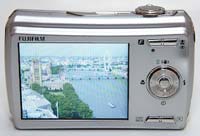 |
| Front | Rear |
Unlike its predecessor, the F50fd, the Fujifilm Finepix F100fd offers no advanced exposure modes, such as shutter-priority, aperture-priority or manual, which is disappointing news for the photographer who wants to take full control. There is a manual mode, but the naming is actually misleading, however, in that it does not allow you to set both the aperture and shutter speed at the same time. Instead, the camera actually sets the aperture/shutter speed, whilst you can change all of the other settings (white balance, exposure compensation and so on). If you buy the Fujifilm Finepix F100fd because you think it has a proper manual exposure mode (or any creative shooting modes), then you will be sorely disappointed.
All 9 external controls are clearly labeled using industry-standard symbols and terminology. Overall the camera body feels very well-designed and not at all cluttered, despite the presence of the large 2.7 inch LCD screen. Note that there is no optical viewfinder on the Finepix F100fd, leading to a few moments of frustration in very bright sunlight when it can be difficult to see the image on the monitor clearly. The F100fd's LCD monitor has a matt finish, compared to the glossy one on many compacts, and it is also slightly recessed, which should lead to fewer scratches. The resolution of 230,000 pixels and 100% scene coverage are also very welcome.
If you have never used a digital camera before, or you're upgrading from a more basic model, reading the comprehensive and fairly easy-to-follow manual before you start is a good idea. Thankfully Fujifilm have bucked the recent trend of not providing hard-copy manuals and supplied it in printed format. The main menu system on the Fujifilm Finepix F100fd is straight-forward to use and is accessed by pressing the Menu/OK button in the middle of the navigation pad and then choosing the Shooting Menu option, which offers 6 options. At the bottom is the Setup option - select this to access 4 more tabbed pages with 22 options that you will probably set once and then forget about. Due to the large LCD screen, the various options and icons are perfectly easy to read.
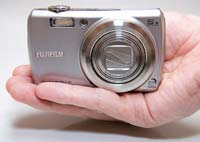 |
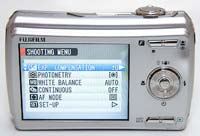 |
| Front | Main Menu |
The F100fd has a few interesting features up its sleeve. The Natural Light mode forces the camera to select a fast shutter speed in order to freeze subject movement more effectively, whilst setting a fast ISO speed without firing the flash for more natural results. It's an effective automatic way of taking photos of children indoors, for example. Intelligent Flash is a little more exciting. This feature is actually a shooting mode called Natural Light and Flash (obviously the marketing department didn't talk to the engineers about the naming convention). When selected, the camera instantly takes 2 photos, one with flash, one without, giving you the option of which one to choose later (both are saved by the camera). The infra-red port on top of the camera allows you to send or receive images (but not movies) to another Fujifilm camera or device with high-speed IR capability. Transmission distance is 5-20cm within a 20 degree angle. Note that the camera compresses the image so that it doesn't take too long to transmit.
The Face Detection 3 function is accessed via a button above the navigation pad. This feature is a welcome one that works well in the right situations. It's really best for posed group shots where your subject(s) is standing still at a moderate distance, but it also works if the subject is moving quickly or has their head turned sideways. Movement tracking keeps the camera 'locked on' to its subjects until they move out of the picture. Face Detection 3 is faster and more accurate than the previous iteration, especially with subjects that aren't looking directly at the camera, and also has the added benefit of also offering red-eye reduction if you require it.
Fujifilm have included an image stabilisation system on the F100fd. Activated by pressing Up on the navigation pad, you can either turn the system on or off. The F100fd's image stabilisation system, called Dual IS Mode, uses a combination of mechanical CCD-shift and the use of high sensitivity settings of up to ISO 6400 to help keep shutter speeds high enough to avoid subject blur in low light conditions. Note that the camera will only automatically adjust the ISO speed when using the Auto or Picture Stabilisation shooting modes - in the other modes the ISO speed that you select will always be used, so only the mechanical CCD-shift part of the system is used. In practice I found that it does make a noticeable difference, as shown in the examples on the Image Quality page. You don't notice that the camera is actually doing anything different when anti-shake is turned on, just that you can use slower shutter speeds than normal and still take sharp photos. Thankfully leaving the anti-shake system on didn't negatively affect the battery-life too much, with the camera managing over 200 shots using the supplied NP-50 Li-ion battery.
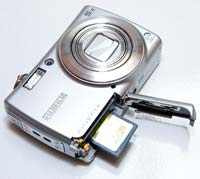 |
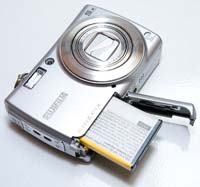 |
| Memory Card Slot | Battery Compartment |
The start-up time from turning the Fujifilm Finepix F100fd on to being ready to take a photo is quick at around 1 second, and it takes about 1.5 seconds to zoom from the widest focal length to the longest. Focusing is very quick in good light and the camera achieves focus most of the time indoors or in low-light situations, helped by a powerful focus-assist lamp. The visibility, resolution and refresh rate of the 2.7 inch LCD screen are good. In the normal shooting mode it takes about 0.5 second to store an image, during which you can't take another picture. In Continuous mode the camera takes 1.7 frames per second at the highest image quality, not particularly quick, and it's limited to only 3 frames. There is a mode that allows you to take an unlimited number of frames, but only at 0.5 sec. intervals. All in all the Fujifilm Finepix F100fd is fairly quick in terms of operational speed.
Once you have captured a photo, the Fujifilm Finepix F100fd has a good range of options when it comes to playing, reviewing and managing your images. You can scroll through the images that you have taken, view thumbnails (up to 100 on the same screen!), zoom in and out, sort images by date, view slideshows with lots of different settings, delete, protect, trim and rotate an image. You can also add a sound clip to an image, transmit an image to another camera via infra-red, remove red-eye, resize for blogging, set the print order and the transfer order. The Display button toggles detailed settings information about each picture on and off, such as the ISO rating and aperture/shutter speed. There is no histogram either in shooting or playback mode.
In summary the Fujifilm Finepix F100fd is very much like its predecessor, the F50fd - a well built and easy to use digital camera with a refined and stylish design. There are two notable differences though, namely the new 5x zoom lens and the removal of any creative shooting modes, which will both attract and put off many people respectively.
|
![]() PhotographyBLOG
is a member of the DIWA
organisation. Our test results for the Fujifilm FinePix F100fd have
been submitted to DIWA
for comparison with test results for different samples of
the same camera model supplied by other DIWA
member sites.
PhotographyBLOG
is a member of the DIWA
organisation. Our test results for the Fujifilm FinePix F100fd have
been submitted to DIWA
for comparison with test results for different samples of
the same camera model supplied by other DIWA
member sites.
